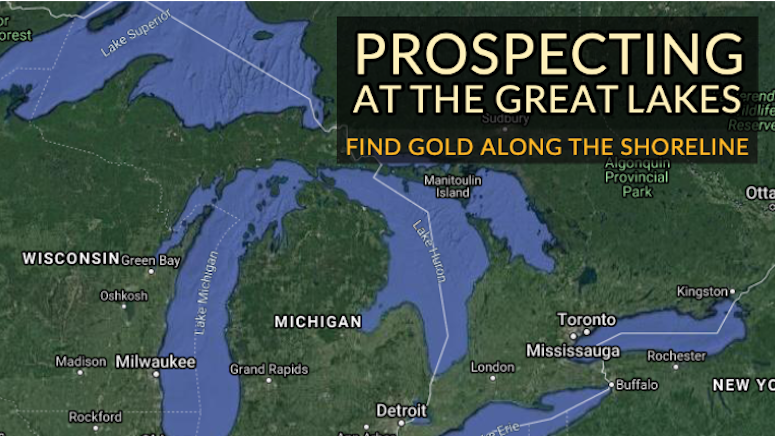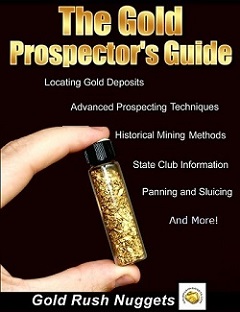
People don’t really consider the Upper Midwest to be a “hot spot” for gold prospecting endeavors. Truth is, aside from a few noted exceptions this area doesn’t have much in the way of native gold.
Yet gold is actually very widespread for reasons that you might not be aware of. Nearly all of the gold in this part of the country was transported down by glaciers during past ice ages. Massive glaciers transported gold down from Canada and scattered it throughout this part of the country.
Believe it or not, the gravels along the shores of the Great Lakes do indeed contain gold! This gold is very, very fine textured and it is hard for a novice to capture even using tried and true methods like panning or sluicing.
Some areas are definitely richer than others. Read on and we will discuss a few places that are popular for gold seekers. Several new mining inventions have also renewed interest with prospectors in this part of the country. That fine gold dust is now easier to capture than it use to be.
The “Hot Spots”
Keep in mind that “hot” is a relative term. You aren’t likely to pay off the mortgage on your house with the gold finds prospecting in this area. What you can expect after a long day of digging is a nice flash of “color” at the bottom of your gold pan. You aren’t going to get rich, but it’s an awesome way to get outside and spend the day.
The lakes further to the west generally have a bit more gold amongst the sands and gravel, with lower concentrations the further east you go. This is likely because the vast gold belt in Ontario is the source of the gold in Lake Superior and Lake Michigan.
Lake Superior definitely has gotten the most attention from gold prospectors. This is probably because there were actually a few legitimate gold mines that operated in the Michigan’s Upper Peninsula. Most notable would certainly be the Ropes Gold Mine, which produced lode gold near Ishpeming. This is one of the few areas in the Great Lakes Region where any appreciable amounts of gold have been found, and therefore it is well-known by gold-seekers.
But the gold that you can find in the sands and gravels along Lake Superior may bot have any association with the Ropes Mine. The source of this gold is actually from glaciation, which pushed down material from the north. There are exceptionally rich gold mines in Ontario, and numerous ice ages pushed auriferous materials to the south.

The south shores of Lake Superior are known for higher than average concentrations of placer gold. Look along the shores in Baraga, Marquette, and Alger Counties. There are plenty of easy accesses to the shoreline in this area and you will have decent chance of finding some gold dust.
There is also gold on in Lake Michigan. Most prospector focus on the western side of the lake simply because that is where the population is. Yes, believe it or not, you can get gold near cities like Green Bay, Milwaukie, and Chicago. Look for unsorted gravels and coarser cobble materials. Around the mouth of rivers and creeks seems to increase the odds of success.
Prospecting is quite popular in Ohio, and there is indeed some gold to find along the banks of Lake Erie, but there are better areas to prospect in this state where you will find more gold. The Buckeye Chapter of the Gold Prospectors Association is very active here and I would recommend you contact them if you want to learn to find gold here.
I have never heard any reports of any gold found along the beaches of either Lake Huron or Lake Ontario. That’s not to say it isn’t there, but most likely in very trace amounts.
The Best Equipment
The recovery of fine gold has been a challenge since the first miner tried to separate out gold dust from gravel.
The basic principle of gold recovery has never changed. Gold is heavy and dense. In fact, it is the heaviest natural element that you are going to find when prospecting. Every prospecting method that exists uses a gravity separation method to separate gold from lighter material.
Keep in mind, it isn’t the weight of the individual piece of gold that matters, but rather the specific gravity of the element. Gold has a specific gravity (SG) of 19.32, many times heavier than other common elements like granite, quartz and hematite.
There is a lot of different types of gold mining equipment out there. Things like gold pans and sluice boxes have been used for centuries because they work. Set up properly, a power sluice with a recirculating pump can recover some very good gold along a beach.
But for serious fine gold recovery, the one thing I now recommend to everyone is the Gold Cube. In my experience, this has got to be the single best mining invention in the past century. It works amazing on the super-fine gold that you can expect to recover in the Great Lakes.
Some Parting Tips
Next: Where You Can Find Native Copper Nuggets in the USA

